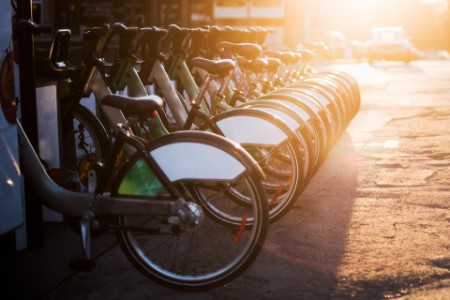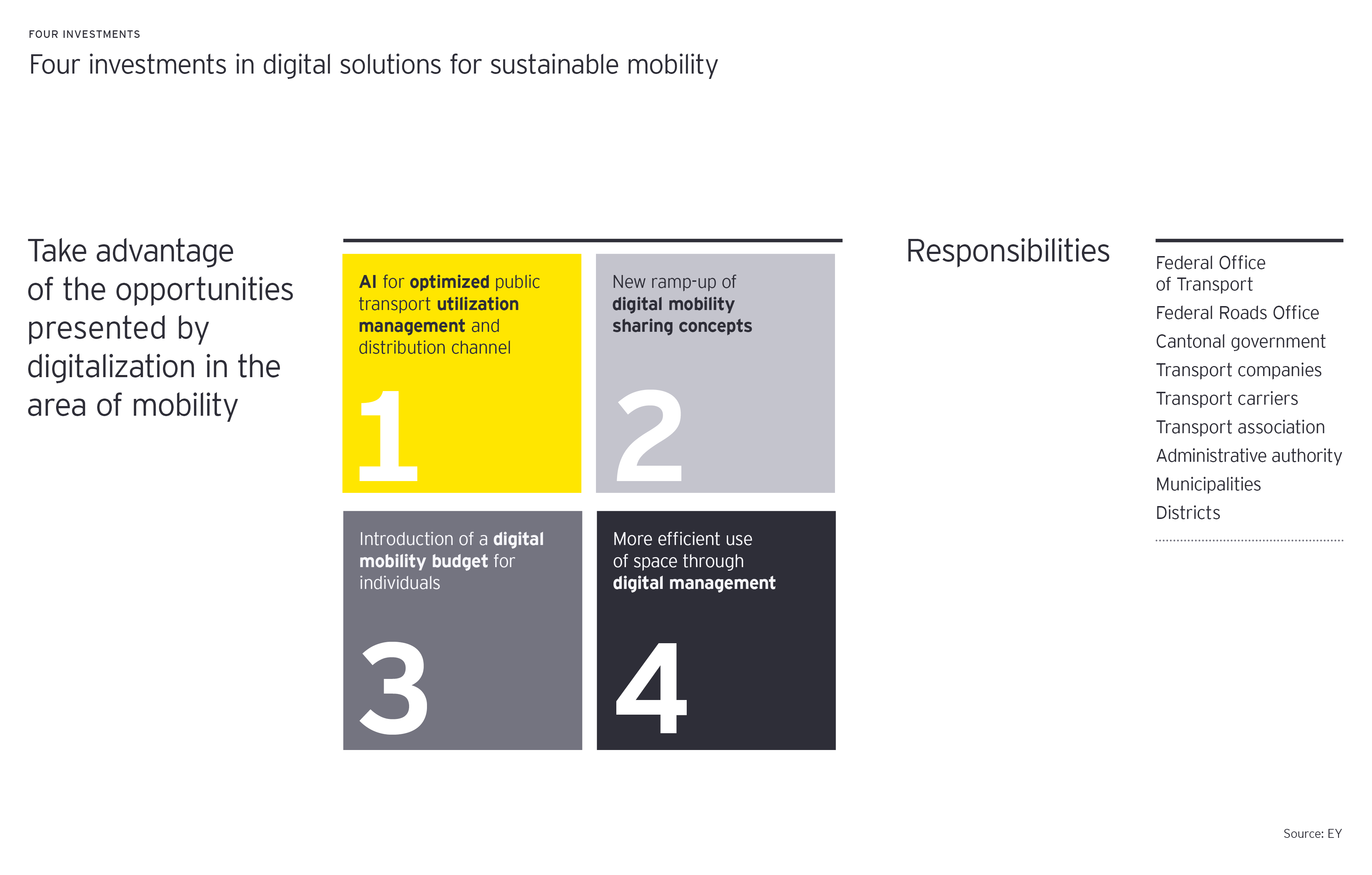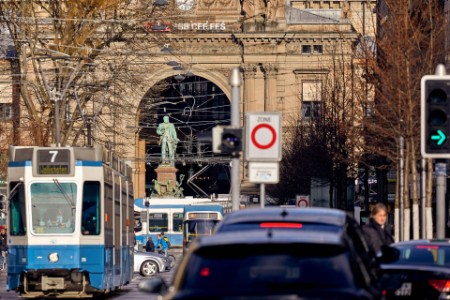
Chapter 1
COVID-19 and its influence on our mobility
How will the new habits affect public transport?
Of all modes of transportation, local public transport is the big loser of the coronavirus crisis. During the exceptional situation presented by the crisis, the number of passengers riding buses and trains in the world’s major cities has plummeted by up to 90 percent. Public transportation not only faces the problem of substantially fewer customers, but it must also ensure that social distancing and hygiene rules are followed. Lars Wagner, the spokesman for the Association of German Transport Companies, says: “If we have the same number of passengers at peak times and require them to maintain a minimum distance of 1.5 meters from one another, then we’d need four times more trains and buses than we currently deploy.”
Although the automotive industry was not spared in the short term, it could benefit from the crisis. New vehicle registrations in Germany fell by 61.1 percent in April 2020 compared with the same period the year before, and the decline in Switzerland was even more pronounced, at 68 percent. But this demand shock may be of a short-term nature. During the crisis, the share of trips by car in Germany rose by 10 percent and interest in owning a car increased by 45 percent among people under the age of 35. According to surveys by Bloomberg, traffic is already higher in large Chinese cities than it was on average last year. Mobility researcher Dr. Thomas Sauter-Servaes of the Zurich University of Applied Sciences, forecasts similar trends for Switzerland and Germany: “Until there’s a vaccine, cars will continue to benefit.”
This is contrasted with providers of mobility services and traditional car-sharing providers, such as Mobility and Ubeeqo, among others. Not only did they have to apply for short-time work for their employees, but in some cases they also had to suspend their entire ride-pooling and hailing operations or adjust their business model. Micro-mobility services, such as e-scooters, e-bikes and Segways, have had to fight for survival too as a result of reduced commuter traffic during the lockdown. The coronavirus has thus weakened the commercial part of the sharing economy and boosted interest in exclusive forms of mobility.
During the initial phase, non-motorized private transport, such as walking and bicycling, will be among the winners of the coronavirus crisis along with the car. Since the restrictions to fight the coronavirus pandemic were implemented, Swiss citizens have covered more than twice as much ground by bike or e-bike than they did in autumn 2019. At the same time, the amount of traffic involving all other modes of transport has fallen drastically. So it’s little wonder that Swiss broadcaster SRF refers to a “bicycle revolution in Europe’s cities.” The triumph of the bicycle won’t last long, however, if we don’t lay the necessary foundation now. In order to make cycling a safe transport mode of choice we need real and not just painted bike paths with the right of way as well as significant investments in better infrastructure and good signage. Cities should only build what they want to keep after the crisis, i.e. they should combine their pop-up infrastructure with long-term goals.
Local public transport is essential to ensure sustainable transport trends
In addition to ensuring good connections between cities and regions, the environmental advantage of public transport compared to motorized private transport is an important reason for the involvement of the public sector. Comparing the utilization and greenhouse gas emissions of public transport with those of private vehicles, public transport is better for the environment: Greenhouse gas emissions per person-kilometer by public transport are less than half the emissions of cars. Environmentally-friendly public transport in, for example, Germany, saves 10.5 million tons of CO2 annually. Less motorized private transport, more support for public transport and the addition of a broad range of sharing options to existing transport infrastructure are the only way to make cities more liveable and ensure the success of the transport transition. Funding rider-oriented and climate-friendly public transport has benefits beyond the environment. The total economic benefits outpace the operational costs on average by a factor of 3.8. Thus, every euro spent is repaid three to four times over.

Chapter 2
A green economic boost is needed: Press ahead with climate protection investments in the mobility and transport sector
To what extent have the agreed economic stimulus packages supported municipal and private rail and bus companies in public transport?
In order for public transport to emerge from the pandemic in a stronger position than before, national and European measures and economic packages must take account of the agreed climate goals, include green pillars and use the EU Green Deal as a long-term compass. Now is the best time to press ahead with planned investments and give not only our economy but also our climate a boost. Efforts to protect the climate and promote the economy should be harmonized.
Three countries – three approaches to economic and climate policy
The fiscal measures taken in Switzerland – amounting to some CHF 70 billion – seem somewhat modest in terms of the amount compared to other countries. Swiss public transport has lost around CHF 500 million17 per month in revenue as a result of the crisis. The Swiss Federal Office of Transport (FOT) responded immediately after the declaration of an extraordinary situation by the Federal Council, moving to ensure the liquidity of transport companies, e.g. by moving up the payout of subsidies that had already been passed. The CHF 1.5 billion loan for Swiss and Edelweiss with no environmental restrictions was controversial. Activists and economists view the promotion of air traffic critically and would prefer to see investments in overnight train lines. In the “crisis action plan” presented by them, they demand that the climate crisis be tackled at the same time as the coronavirus crisis. They call for the Federal Council, rather than offering a loan with no conditions, to invest in car-free cities, low-emission vehicles, more bike paths and charging stations for e-bikes and electric cars.
Electric mobility is one of the winners in Germany’s EUR 130 billion package for economic growth and the future: Instead of a new scrappage premium, the existing “environmental premium” is rising to as much as EUR 9,000. However, the environmental premium for electric cars falls short and will not help to protect the environment in the long term. The range of available electric car models is too small and the federal government is promoting products that the industry does not (yet) offer. Structural change is long overdue. A true transformation of our current mobility options can only succeed if electro-mobility is viewed as an innovation system. Here, the interaction of technological and social innovations, such as the integration of electric cars in a collaborative mobility system with intermodal transport concepts, is crucial. German Minister of the Environment Svenja Schulze and four economic research institutions are therefore promoting a mobility transition as part of the economic package. In addition to investments in local public transport, they want to see an end to tax exemptions and tax breaks for kerosene, diesel fuel and company vehicles.
By comparison, Austria has initiated a very proactive process. The Austrian government has announced that it plans to invest EUR 300 million in rail transport, the modernization of train stations and efforts to make public transport more attractive by adding bicycle stands and park-and-ride options. The move was praised by WWF Austria on Twitter: “The economic package is a step in the right direction. The further expansion of public transport will help the labor market, strengthen the economy and improve the quality of life.” In addition, Leonore Gewessler, the Austrian Minister for Climate Action, Environment, Energy, Mobility, Innovation and Technology, plans to reduce the rail toll and to move up the introduction of a “1-2-3 ticket” intended to simplify train ticket pricing.

Chapter 3
Four investments in digital solutions that can strengthen sustainable mobility
What do transport planners, providers and governments need to consider now in order to be successful in the face of new mobility behaviour?
Our growth-promoting investments, which are intended to overcome the economic effects of the coronavirus pandemic, must also meet the challenge of climate neutrality. For this reason, the agreed climate goals should be taken into account during the economic rebuilding, with new structures being established and the challenges before us being addressed proactively. Public transport is the backbone of mobility for a successful transport transition, and even before the crisis it played a crucial role in achieving climate goals. In order to be able to comply with the current social distancing rules, the capacity of public transport will have to be increased significantly. However, this involves long planning cycles and investments. What short-term measures can be used to strengthen public transport in order to prevent old and new uses of motorized private transport from making a comeback?
Digitalization offers the greatest opportunity to reorganize mobility in an environmentally-friendly and secure manner by simplifying access to sustainable mobility services and strengthening smart mobility applications. We must use digital tools in a way that utilizes public transport efficiently while at the same time making it a secure mode of transport.
The following four investments in digital solutions can strengthen sustainable mobility

Please find more background information about the article here.
Summary
A broad range of mobility offerings can be established with the help of digital technologies. Such technologies not only helped to provide quick relief during the coronavirus crisis, but can also be used to strengthen access to sustainable mobility options. No matter whether new behaviors are continued or we return to the old normal again, we need a more environmentally-friendly, efficient and secure mobility and logistics concept. This pandemic offers an important window for implementing the specified measures and transport improvements. National legislatures have the power to provide cities, towns and villages with the organizational tools need for environmentally-friendly digital mobility. Without corresponding measures it is conceivable that – even if mobility behavior and volumes change – the climate goals will not be achieved.


